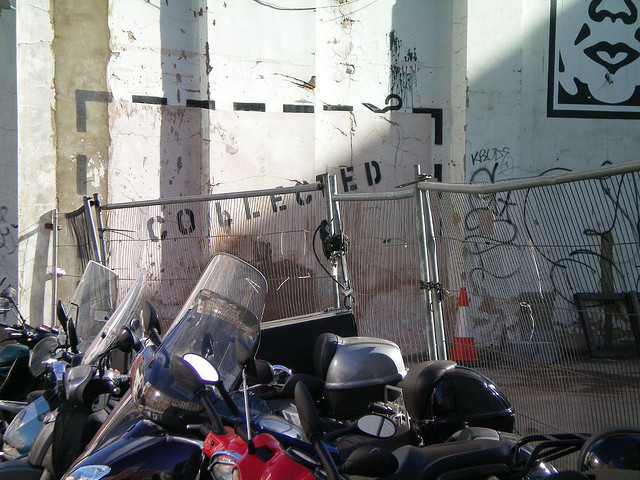
Back in February, there was an auction in Miami that included the sale of street pieces formally by Banksy. Shortly before that auction took place, Caroline Caldwell interviewed the auction house’s representative, a so-called “street art expert.” We decided that since the auction felt like a joke and the very claim of “street art expert” sounded like a joke, we didn’t want to ask serious questions, lest that might suggest that he was worth taking seriously. But we did see an opportunity to have a bit of fun at the expense of their “expert,” so Caroline interviewed him in a style befitting The Daily Show or The Colbert Report.
Not everyone agreed with our strategy. A few people criticized us for missing a chance to ask hard-hitting questions about an important topic. While we don’t believe that the salesman we were interviewing would have said anything insightful about the sale he was promoting, we do agree that it would be great to ask thoughtful questions of someone who facilitates the sale of street pieces. Recently, we had that opportunity.
Next week in London, The Sincura Group will be holding a similar auction of street pieces formally by Banksy. That’s the same company that last year successfully sold the Banksy “Slave Labour” wall at auction for just over $1 million. They’ve titled their auction Stealing Banksy? and it will include approximately 18 works, at least 7 of which are street pieces formally by Banksy that have been removed from their original locations, some of them specifically removed for this sale.
The difference between Fine Art Auctions Miami, the auction house with the “street art expert,” and The Sincura Group is that The Sincura Group does not come across as a complete joke. The Sincura Group has publicly tried to address some of the logistical and ethical issues surrounding the sale of street pieces. By titling their auction Stealing Banksy? and calling it a “project exploring the social, legal and moral issues surrounding the sale of street art” rather than just an auction, they try to position themselves as observers to a phenomenon that they want to see debate about, rather than facilitators and promoters of the ethically questionable market for street pieces. They have released statements about their work, making what they do appear to be a somewhat transparent, thought-out and ethically sound process while acknowledging some criticisms like rational people. If you’re just a casual observer, they do an alright job looking like the good guys, a group of people willing to engage in thoughtful debate.
That’s why we decided to interview Tony Baxter, Director of The Sincura Group, and this time, we thought it was appropriate to ask real questions to challenge the way The Sincura Group bills themselves. Caroline wrote the initial draft of our questions, which we then edited and added to collaboratively. Because our time is limited by the fact that we are not a professional news outlet but rather full-time students, we decided to conduct the interview over email. Email is not the ideal format for something like this, but it’s better than no interview at all.
Frankly, RJ finds some of Mr. Baxter’s answers misleading, but he’ll save more of his thoughts on that for tomorrow, when we will publish a response to this interview on Vandalog (UPDATE: Here’s RJ’s response). In the mean time, here’s the interview…
Vandalog: Records that we found show that The Sincura Group LTD was dissolved in March of 2014 under section 1000 of the Companies Act 2006. Is that information correct? Is the company still operational, and is Stealing Banksy? still happening?
Tony Baxter, Director of The Sincura Group: you are looking at the wrong company – The Sincura Group is a group of companies
Vandalog: On a similar note, what is your role at The Sincura Group? While previous articles in the press and your email signature cite you as a director of The Sincura Group, records also show that, legally speaking, Tara Leers is the sole director of the company.
Baxter: again, you are looking in the wrong place
Vandalog: If as of yet you “have made no financial gain from the sales of street art,” what is the incentive to be involved? Are you attempting to eventually profit directly or indirectly from these sales, perhaps by attracting clients to the for-profit services of The Sincura Group?
Baxter: We are a concierge company, and use these events to showcase the range of services we offer, and extent of contacts we have. We were the only company to unearth the true story behind ‘Slave Labour’ last year, and the only company to bring it back to the public domain. At the end of the day, someone is going to do this – be it us or another person. By us doing it at least we can ensure that it is done properly and that the pieces are removed and restored by the world’s leading experts.
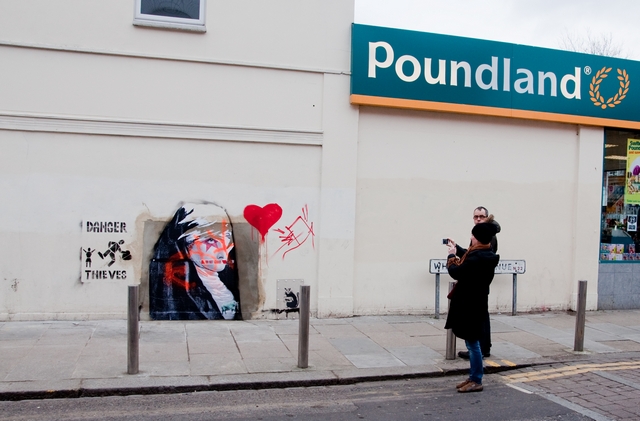
Vandalog: In your experience, how do the people who bid on street pieces tend to perceive their relationship with the artist?
Baxter: Let’s not beat about the bush here, the people who buy these pieces are ‘big game hunters’. They want the very best, at any price.
Vandalog: Does the amount of time a piece has been on the street affect its value? What about the additions of work by other street artists or graffiti writers?
Baxter: The amount of time on the street has no effect on the value, the main effect on the value is the amount of time the piece has been relevant or in the press. Nothing could illustrate this more than the recent bristol piece, it was on the street for a mere 2 hours, and yet is currently the most famous piece in the world. This was created by the press and media hype, and when it comes to sale it will sell at a price set by this hype.
Vandalog: You mention that you explain the social impacts of removing street art to the property owners who approach you. What are the social impacts of removing street art?
Baxter: Banksy gifted these pieces to the community. And they make social statement for the community. And first and foremost we are art lovers. We do not approach anyone to remove their artwork.
However, by having a Banksy on your wall you run the real risk of having a grade 2 listing put on your building which affects your resale value. These building owners don’t want the pieces on their walls. They don’t want the attention and they don’t want the issues surrounding the pieces.
If someone paints graffiti on your wall the council make you remove it or face a £2,000 fine. Yet for Banksy it is different. The building owners never asked for it, they don’t want it.
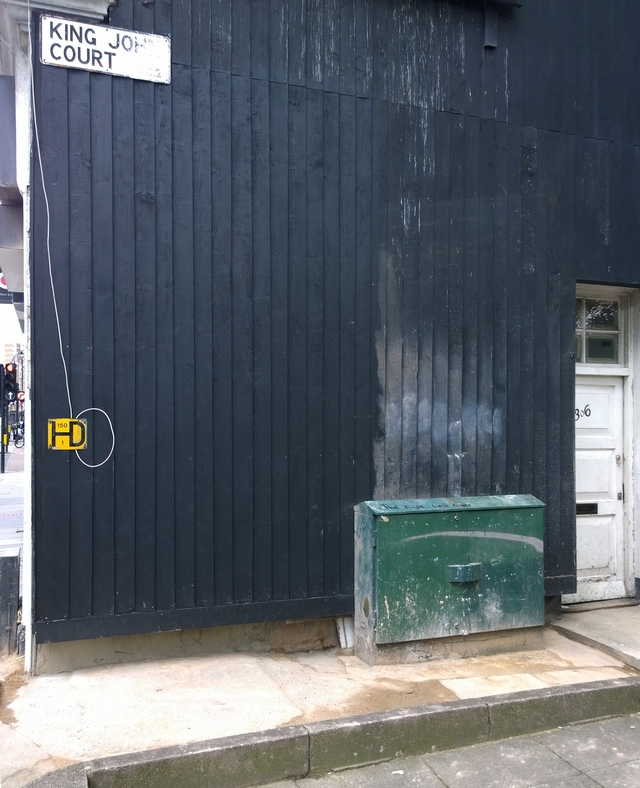
Vandalog: Although you claim on the Stealing Banksy? website to list the charities that will benefit from these auction, we can’t find that list anywhere on the site. Which charities will be benefiting from which items being sold, and approximately how much will each charity be benefiting? Are the charities aware of the possible donation?
Baxter: The main charity is The Nelson Mandela Children’s Fund (UK). They receive a share of all ticket sales, auction registrations, art sales, and corporate events. Each piece then has an affiliated charity chosen by the owners – and donations vary on each sale. We encourage the owners to choose local charities to benefit the community from where the piece originated. As an example 100% of the profits from the sale of No Ball Games will be given to the local charity Step by Step, which helps underprivileged children in the Tottenham Area.
Vandalog: On the Stealing Banksy? website, it is stated, “To date we have made no profit from the sales of Banksy street art and actively discourage it’s removal.” Given your auctions, that disclaimer sounds to us like someone saying, “I discourage the sale of illegal drugs, but if you want some illegal drugs, come over to my house tomorrow and meet my buddy Paul. He’ll bring the drugs.” If all of the 7-17 Banksy street pieces that your website suggests will be included in the Stealing Banksy? auction sell, your group will probably have sold more Banksy street pieces than any other individual or company. By facilitating the sale of walls, from offering consulting and assistance to putting on auctions and drawing media attention to the sales, how can you claim that you are discouraging people from removing and selling Banksy street pieces? Don’t your practices play a major role in creating a market for that work?
Baxter: I am not saying that what we do is the best solution, and if you can suggest better then please do. I see us as the lesser of two evils, for the following reasons:
- These pieces will be removed with or without our help, and it is only when we are satisfied of this do we get involved (we get about 10 enquiries a week asking us to remove banksys and most times say no)
- We can ensure that the world’s leading experts are used to facilitate the process, at a huge expense. Without us these building owners can pay a local builder £500 to ultimately destroy these pieces by doing an amateurish job.
- We ensure that a local charity benefits from the sale of the artwork
- We ensure that in 100 years’ time these pieces of art are still in the public domain. Please remember that pieces like “Girl With the Red Balloon” had been covered by advertising billboards for 10 years, was forgotten, and in 2 years’ time would have been lost forever. Instead we are restoring it (at a cost of over £100k), will sell it, and will gift the community charities a lot of money. And in 100 years’ time the piece will still be here.
As I say, this is not ideal, the council do very little to protect these pieces. They put plastic covers on them but this actually damages them more than it saves them, the wall can’t breath and they build up bacteria. Below is a picture of No Ball games pre and post restoration.
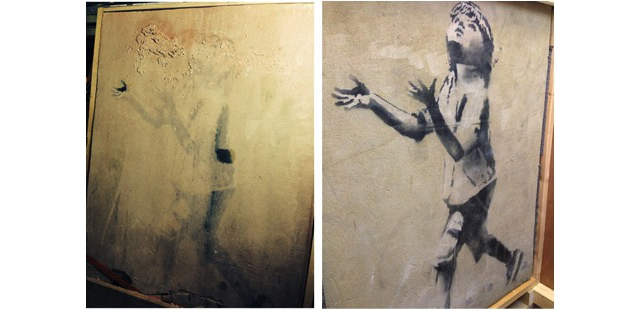
Vandalog: Do you consider the street pieces that you sell to still be cohesive and complete artworks once they have been removed from the street?
Baxter: Absolutely. People ask us why we don’t simply paint over the lines. But that ruins the integrity of the piece. Our restorers spend up to a year with cotton buds restoring these pieces. We never add or remove anything from the pieces, we simply bring them back to life. Yes they lose the local context, but they maintain their integrity as a piece of artwork.
Vandalog: Are you at all concerned that the removal and sale of Banksy street pieces may violate the moral rights of the artist, and if so, has that had any bearing on why you hold your auctions in the UK?
Baxter: Lets remember these are illegally painted artworks, and Banksy relies on events like this (and press coverage like yours) to keep his stock value high.
Vandalog: What does it mean that the Boy with Heart piece “has full providence [sic],” if it has not been authenticated by Pest Control? Would you not consider Pest Control’s authentication part of establishing the provenance of an artwork by Banksy?
Baxter: banksy is self-authenticating by listing his pieces in his books or publications
Vandalog: Why do you think the top tier international auction houses have stayed away from selling Banksy street pieces, with a Christie’s representative even stating outright that they will not sell Banksy street pieces?
Baxter: these are multi-million pound businesses who trade in masters and classics (which incidentally we do aswell to our private audience). They do not need to be involved in ‘lesser’ auctions like these. The smaller auction houses have tried, unsuccessfully, to move banksy pieces.
Vandalog: You have said that you “vet all buyers to ensure they are ethically sound.” How do you do that and what are some examples of things that would qualify as ethically sound or unsound?
Baxter: We make sure the pieces go in to collections owned by ethically sound individuals or corporates, and that they are not indirectly involved in activities that would jeopardise the piece, the charities, or our company through direct involvement. We are a very well connected network and have a lot of information available to us through our extended sources.
UPDATE: You can read RJ’s response to Baxter’s answers over here
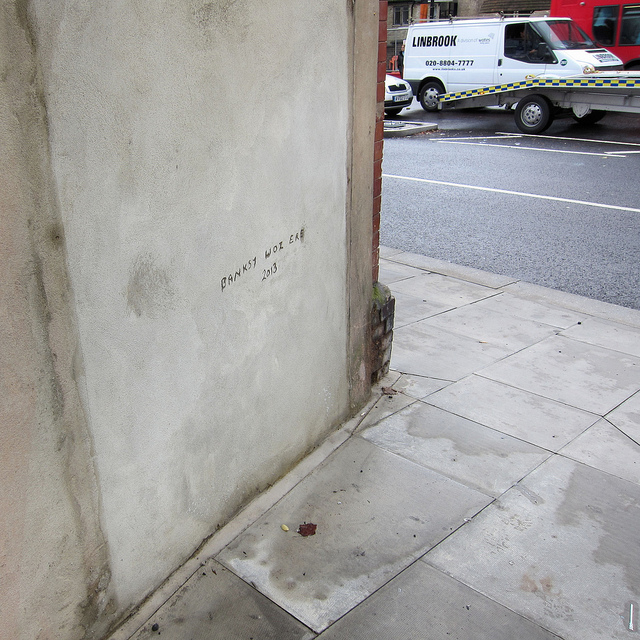
Photos by Dave NoLionsinEngland of Shoreditch Street Art Tours, eddiedangerous and Alan Stanton and courtesy of The Sincura Group
